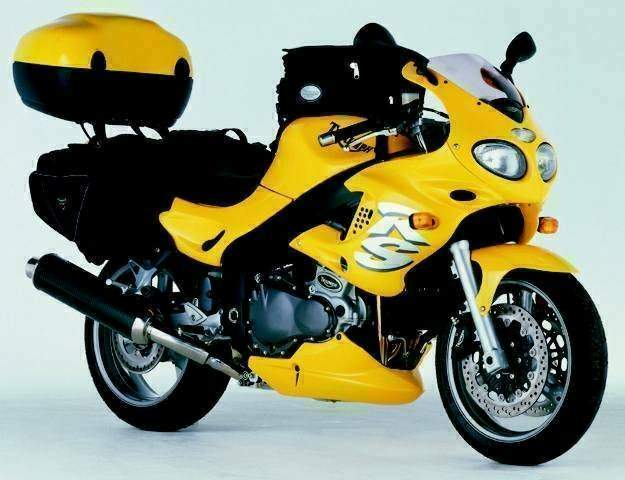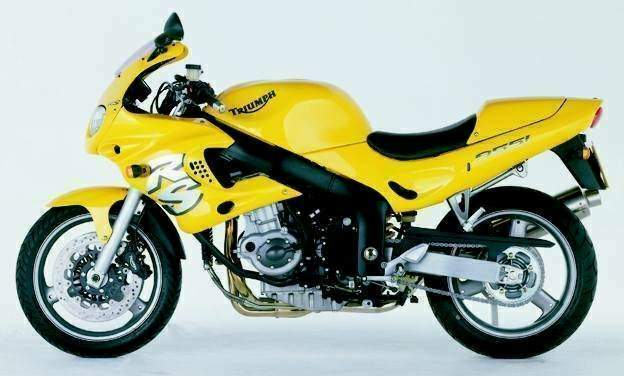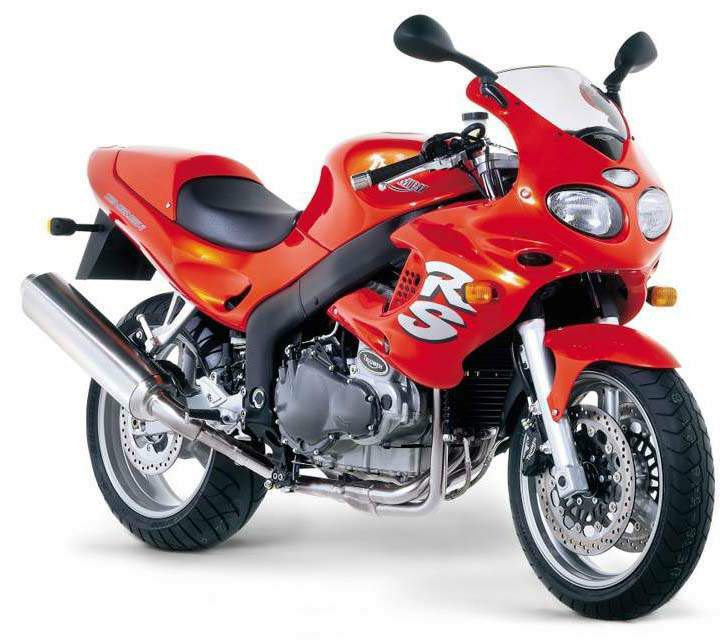
|
|
|
|
|
|
Classic Bikes
Custom Bikes
Individual
Racing Bikes AJP
AJS
Aprilia
Ariel
Avinton / Wakan
Bajaj
Benelli
Beta
Bimota
BMW
Brough Superior
BRP Cam-Am
BSA
Buell / EBR
Bultaco
Cagiva
Campagna
CCM
CF Moto
Combat Motors
Derbi
Deus
Ducati
Excelsior
GASGAS
Ghezzi Brian
Gilera
GIMA
Harley Davidson
Hero
Highland
Honda
Horex
Husaberg
Husqvarna
Hyosung
Indian
Jawa
Kawasaki
KTM
KYMCO
Laverda
Lazareth
Magni
Maico
Mash
Matchless
Mondial
Moto Guzzi
Moto Morini
MV Agusta
MZ / MuZ
NCR
Norton
NSU
Paton
Peugeot
Piaggio
Revival Cycles
Roland Sands
Royal Enfield
Sachs
Sherco
Sunbeam
Suzuki
SWM
SYM
Triumph
TVS
Ural
Velocette
Vespa
Victory
Vincent
VOR
Voxan
Vyrus
Walt Siegl
Walz
Wrenchmonkees
Wunderlich
XTR / Radical
Yamaha
Zero
Video
Technical
Complete Manufacturer List
|
Triumph Sprint RS
|
| . |
|
Make Model |
Triumph Sprint RS |
|
Year |
2000 |
|
Engine |
Four stroke, transverse three cylinder. DOHC, 4 valves per cylinder |
|
Capacity |
955 cc / 58.3 cu in |
| Bore x Stroke | 79 x 65 mm |
| Compression Ratio | 12.0:1 |
| Cooling System | Liquid cooled |
| Lubrication | Wet sump |
|
Induction |
Multipoint sequential electronic fuel injection |
| Engine Oil | Synthetic, 10W/40 |
|
Ignition |
Digital CDI |
| Spark Plug | NGK, CR9EK |
| Starting | Electric |
|
Max Power |
80.2 kW / 110 hp @ 9200 rpm |
|
Max Torque |
97 Nm / 9.89 kgf-m 71.5 lb-ft @ 6200 rpm |
| Clutch | Wet, multiple discs, cable operated |
|
Transmission |
6 Speed |
| Final Drive | Chain |
| Frame | Aluminium, twin spar |
|
Front Suspension |
45 mm Forks with dual rate springs and adjustable preload. |
|
Rear Suspension |
Monoshock with adjustable preload, compression and rebound damping |
|
Front Brakes |
2 x 320mm Discs, 4 piston calipers |
|
Rear Brakes |
Single 255 mm disc, 2 piston caliper |
| Wheels Front | Alloy 3 spoke, 17 x 3.5in |
| Wheels Rear | Alloy 3 spoke, 17 x 5.5in |
|
Front Tyre |
120/70-17 |
|
Rear Tyre |
180/55-17 |
| Rake | 24.5º |
| Trail | 80 mm / 3.1 in |
| Dimensions |
Length 2120 mm / 83.5 in Width 735 mm / 28.9 in (handlebars) Height 1170 mm / 46.1 in |
| Wheelbase | 1470 mm / 57.9 in |
| Seat Height | 805 mm / 31.7 in |
|
Dry Weight |
199 kg / 438 lbs |
|
Fuel Capacity |
19.5 Litres / 5.2 US gal / 4.3 Imp gal |
|
Consumption Average |
5.1 L/100 km / 19.8 km/l / 46.6 US mpg / 55.9 Imp mpg |
|
Standing ¼ Mile |
11.2 sec |
|
Top Speed |
238.3 km/h / 148.1 mph |

The Sprint RS is a half-faired variant of the Sprint ST sports tourer. Cheaper than the ST, it is aimed at riders who want a sportier ride than the ST, but with the good road manners of the Sprint chassis and engine. The chassis is largely the same as the ST, with the exception of the swingarm: the RS wears a cheaper, lighter double-sided swingarm rather than the ST's single-sided item. This change, and with less bodywork, gives the RS a hefty 8kg (181b) weight advantage over its sibling. Suspension and brakes are unchanged from the ST. The latest 2002 version of the RS is fitted with the same 955cc engine as the Speed Triple and the ST. The three-cylinder engine is a refined, well-developed powerplant with plenty of power and torque.
Review
Triumph's Sprint RS. Greg Leech reckons it's been an underrated option for long enough. Lookout. Now it's got grunt... Let's get one thing out of the way before we even start here. I am an unashamed fan of Triumph's philosophy of sticking with the three-cylinder in-line configuration. It's been said a million times, but only because it's true. With a triple you get the low-down pull of a twin and the top-end rush of a four. At least a fair degree of both anyway. And doesn't that make a world of sense?
So it follows with the latest Sprint RS.It's a bike capable of fairly long stints via a sensible seating position and average-to-good fairing protection and it's built to very competitive price but never feels like it. Looks are a little sedate for mine, but the jewel in the crown is that engine. Oh, that engine. Let's get to that in a moment...
When I tested the first incarnation of the bike on its Australian launch in 2000, this was how I saw it: "Fun by the bucketload, aggressive pricing and more than a modicum of comfort. "There will be those that won't like the half-fairing and there will be those that consider the whole thing a little soft, but if you're looking for an all-rounder with a little Euro chic, this could well be your baby." Well, most of that remains true when we look at the 2002 version of Triumph's bargain-priced, sports touring offering, but a host of changes have improved the bike enough for me to suggest that the RS can no longer be considered anything like soft. How so? Simple my friends - grunt. Yep, now there are now 120 ponies snorting inside that lovely triple. Let's look at what put them there.
The Sprint RS's new mill is the same as the new 955cc three-cylinder engine fitted to the delightful Speed Triple. Using high-pressure die-cast crankcases, the DOHC 12-valve, liquid-cooled engine's new cylinder head makes use of 1mm larger inlet valves and 1mm smaller exhaust valves, set at a narrower included angle. Both inlet and exhaust ports are redesigned for better gas flow and new cast pistons run in steel liners. The compression ratio is raised from 11.2:1 to 12:1 while crankcase breathing is revised to minimise power loss. The new engine is a whole 2.5kg lighter than its predecessor.

Check out the accompanying yarn for all the other new goodies and bits you can add-on... Let's get this party started...
Our launch timetable saw us on just about the best road in Australia. Yep, the Great Ocean Road. It's a stretch of blacktop that demands a whole lot of both a bike and indeed its rider. Perfect. The bike is no shortie and with a wheelbase of 1470mm it doesn't turn in at rocket-ship pace. There are definitely sports mounts about that will dump into a line more quickly, but the up-side is nice stability. There are no bar-flapping escapades when getting serious and you really can nail that engine nice and early on the exit. It's a great mix for tight corners - set the whole thing up well on the entrance and whack open the taps on the way out. It might be just me, but that's how I like to ride anyway - especially on a road like the GOR. Slow in and fast out is the name of the game here. Mr Safety demands it...
The suspension arrangement is fairly elementary with preload on the front and preload and rebound at the stern. Truth is I rode the bike on standard settings and had no stress whatsoever. Those adjustments are geared towards rider and load weight more than getting tenths out of your lap times. In fact, if you're looking for tenths on the GOR, would you mind riding with someone else please?
The company line
How does triumph Australia see the RS. We asked Dealer Development Manager Gary
McDonnell had this lot to say...
"For some unexplainable reason the Sprint RS has always trailed in the wake of the ST, when in fact it has the edge over the ST and deserves to be treated as a separate model in its own right. It does everything the ST does - only better ! The slightly steeper head angle, flatter bars, stiff twin spar swingarm and less weight, makes the RS very nimble through the turns, taking advantage of the high torque produced by the "new generation 955" Daytona-derived engine. The cherry on the cake is the fabulous retail of only $14,490.
"Sales of the RS have increased this year I think due to recent press exposure, the keen retail and I feel that bike purchasers want value for money and are confused with what actually is the retail of Japanese bikes on offer. It leaves a nasty taste in the mouth when, after buying a Japanese bike you could have bought it $2000 cheaper by waiting a month or so."
So. Should you buy one?
Well, I'd buy one over the fully-faired ST because I reckon the sharper focussed
RS is currently Triumph's best offering, In fact, Daytona riders might like to
keep a close eye on their mirrors. Ditto Japan Inc...
I'm talking real-world, fair-dinkum, get your hand off it, useability. The RS will be bought by those that think long and hard about their bike-purchasing decision. Pity we don't always do that...
Source BikePoint

|
Any corrections or more information on these motorcycles will be kindly appreciated. |